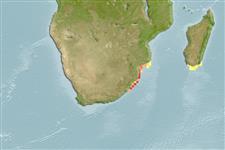>
Pleuronectiformes (Flatfishes) >
Cynoglossidae (Tonguefishes) > Symphurinae
Etymology: Symphurus: Greek, syn, symphysis = grown together + Greek, oura = tail (Ref. 45335); monostigmus: Name from the Greek word 'manos' (= one) and 'stigma' (= spot), referring to the single, conspicuous, black spot on the anteroventral region of the ocular side of the abdomen..
Environment: milieu / climate zone / depth range / distribution range
Ecologia
marinhas demersal; intervalo de profundidade 65 - 110 m (Ref. 57441). Temperate
Western Indian Ocean: South Africa.
Tamanho / Peso / Idade
Maturity: Lm ? range ? - ? cm
Max length : 5.5 cm SL macho/indeterminado; (Ref. 57441)
Raios dorsais moles (total) : 86; Raios anais moles: 73 - 74; Vértebras: 48. This species is distinguished by having an irregular, conspicuous, dark spot overlying the anteroventral ocular-side body cavity; a 1-2-2-2-2 ID pattern; caudal-fin rays 14; D 86; A 73-74; vertebrae, abdominal 9 (3 + 6), total 48; hypurals 5; longitudinal scale rows 92; transverse scale rows 36-38; scale rows on the head posterior to lower orbit 18-19; body deep (BD = 28.8-32.4% of HL); preanal length short (PAL = 21.3-25.5% of SL); upper head lobe much wider than lower lobe; head moderately short (HL = 18.0-20.2% of SL), with head length much shorter than head width (HW/HL = 1.38-1.42); postorbital length long (POL = 75.8-79.4% of HL); snout short (SNL = 13.6-14.8% of HL; SNL/ED = 1.08-1.25), rounded to obliquely blunt anteriorly; dorsal-fin origin at vertical at anterior margin of upper eye; predorsal length short (PDL= 16.4-19.3% of HL); eyes equal in position (anterior margin of upper eye equal with anterior margin of lower eye), or slightly subequal (with anterior margin of upper eye anterior to that of lower eye); no fleshy ridge on ocular-side lower jaw. Colouration: ocular-side pigmentation yellowish-white with numerous freckles along bases of dorsal- and anal-fin rays; blind-side pigmentation uniformly white; peritoneum bluish-black (Ref. 126065) .
Life cycle and mating behavior
Maturities | Reprodução | Spawnings | Egg(s) | Fecundities | Larvas
Munroe, T.A., 2006. New western Indian Ocean tonguefish (Pleuronectiformes: Cynoglossidae, Symphurus). Copeia 2006(2):230-234. (Ref. 57441)
Categoria na Lista Vermelha da IUCN (Ref. 130435)
Ameaça para o homem
Harmless
Utilização humana
Ferramentas
Relatórios especiais
Descarregue XML
Fontes da internet
Estimates based on models
Phylogenetic diversity index (Ref.
82804): PD
50 = 0.5000 [Uniqueness, from 0.5 = low to 2.0 = high].
Bayesian length-weight: a=0.01445 (0.00647 - 0.03228), b=3.05 (2.85 - 3.25), in cm total length, based on LWR estimates for this (Sub)family-body shape (Ref.
93245).
Nível Trófico (Ref.
69278): 3.2 ±0.4 se; based on size and trophs of closest relatives
Resiliência (Ref.
120179): Elevada, tempo mínimo de duplicação da população menor que 15 meses (Preliminary K or Fecundity.).
Fishing Vulnerability (Ref.
59153): Low vulnerability (10 of 100).
